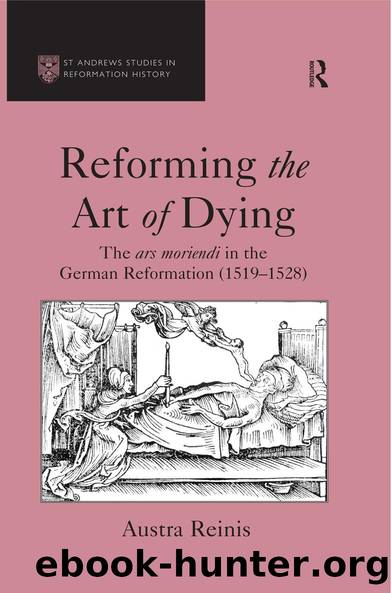Reforming the Art of Dying by Austra Reinis

Author:Austra Reinis [Reinis, Austra]
Language: eng
Format: epub
Tags: History, General
ISBN: 9781351905718
Google: pKqoDQAAQBAJ
Publisher: Routledge
Published: 2016-12-05T16:19:46+00:00
Euangelisch lere vnd vermanung / eines sterbenden menschen ⦠[1523]
When you are lying on your deathbed, the devil will assault your faith, or will send to you messengers from the Pope, in order that they turn you from holy scripture to human laws, teachings and superstitions. [This they will do] in the name of the holy Christian church, of whom they are truly enemies.1
The Euangelisch lere, published by Wolffgang Stoeckel in Leipzig in 1523, advises the dying Lutheran how to speak to the priest who has come to hear his confession and to administer last rites. What circumstances might have led a Lutheran to call for a priest? Leipzig in June and July of 1519 had witnessed the first public debate over the Reformation, in which Johannes Eck, Andreas Bodenstein von Karlstadt and Martin Luther had participated. The evangelical movement began to gain ground, especially among merchants and artisans. In the Johanniskirche Stephan Schonbach and Sebastian Froschel began preaching in 1522 and 1523, respectively. Andreas Bodenschatz preached at the Cistercian convent of St George in 1523â24.2 At the same time, the university and clergy remained loyal to Rome, as did the territorial ruler, Duke George the Bearded. In 1522 the latter prohibited the printing and sale of Lutherâs writings in Leipzig and in 1523 he expelled the evangelical preacher Sebastian Froschel.3 Notwithstanding such measures, Lutheran sentiment in Leipzig remained strong.4 As the entries under 1522 and 1523 in Helmut Clausâ bibliography of Leipzig publications demonstrate, printers continued to print books by Luther and his supporters.5
The Euangelisch lere is a publication belonging to this period. It suggests that at least some Lutherans may have wished to spare their families the shame associated with having a relative buried as a heretic in unconsecrated ground. Craig Koslofsky reports that beginning in the late 1520s Leipzigers who sympathized with the Reformation began to refuse deathbed communion, final confession and extreme unction. On 24 August 1529 Duke George responded by ordering that the provost and the council should ânot permit . burial among the gathering of the faithful of any persons who died without the sacramentsâ.6
The pamphlet Euangelisch lere suggests that the threat of being refused a decent burial on account of oneâs evangelical convictions may have existed from the very beginning of the Lutheran movement. If this was the case, then a desire for honourable burial on the part of at least some Lutherans would likely have led this author to propose that a Lutheran might request the traditional last rites, providing that in his heart he interpreted these rites in a Lutheran way.
Instruction in the Lutheran way of understanding last rites is the principal purpose of the Euangelisch lere. Nevertheless, the pamphlet seems to have a secondary, broader purpose as well: to teach Lutherans how to live according to their evangelical convictions while avoiding confrontation and harassment by hostile authorities. This secondary purpose is evident in several rubrics which do not expressly speak to the deathbed situation, among them âWhen there is a feast dayâ and âOn Sundaysâ.
Download
This site does not store any files on its server. We only index and link to content provided by other sites. Please contact the content providers to delete copyright contents if any and email us, we'll remove relevant links or contents immediately.
Getting It, Then Getting Along by L. Reynolds Andiric(631)
Religion and Politics Beyond the Culture Wars : New Directions in a Divided America by Darren Dochuk(451)
Global Justice, Christology and Christian Ethics by Lisa Sowle Cahill(411)
Positive Psychology in Christian Perspective: Foundations, Concepts, and Applications by Charles Hackney(342)
Forgiveness and Christian Ethics by Unknown(329)
Douglas Hamp The First Six Days by Unknown(257)
The Horrors and Absurdities of Religion by Arthur Schopenhauer(243)
Insurgency, Counter-insurgency and Policing in Centre-West Mexico, 1926-1929 by Mark Lawrence(234)
Christian Martyrdom and Christian Violence by Matthew D. Lundberg;(223)
The Oxford Handbook of Greek and Roman Mythography by R. Scott Smith;Stephen M. Trzaskoma;(217)
Beyond Heaven and Earth by Gabriel Levy(210)
God and Eros by Patterson Colin;Sweeney Conor;(208)
The Bloomsbury Reader in Christian-Muslim Relations, 600-1500 by David Thomas;(205)
Autobiography, Volume 2: 1937-1960, Exile's Odyssey by Mircea Eliade(197)
Cult Trip by Anke Richter(194)
Witches: the history of a persecution by Nigel Cawthorne(192)
An Introduction to Kierkegaard by Peter Vardy(179)
The Myth of Disenchantment by Jason A. Josephson-Storm(174)
The Global Repositioning of Japanese Religions by Ugo Dessi(173)
